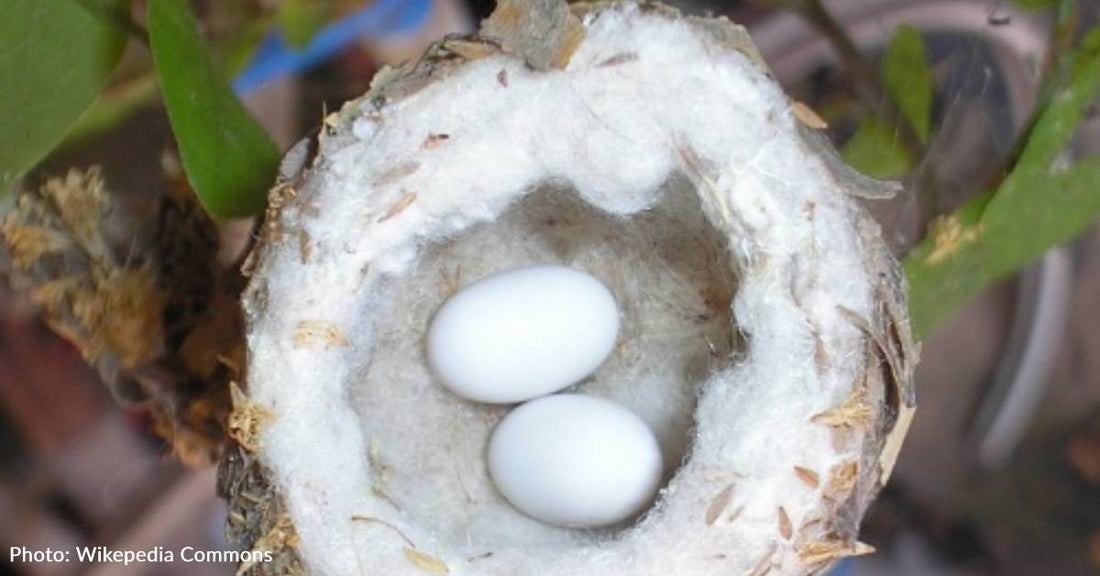These Tiny Eggs And Nests In Your Yard Belong To Hummingbirds And They Are Protected By The Law
Chantelle Dixon
When doing yardwork this year, take a closer look at your shrubs and trees before doing any trimming -- there may be tiny hummingbird nests tucked away in the branches.
Everyone knows hummingbirds are small creatures -- but their nest and eggs are really, really small. For example, a typical hummingbird nest weighs about one tenth of an ounce. The Ruby-throated hummingbird's nest is roughly the size of a thimble. And the eggs? They're about the size of jelly beans or navy beans.
 Photo: Wikimedia Commons/Scheihing Edgardo
Photo: Wikimedia Commons/Scheihing Edgardo
It's pretty easy to miss something the size of a thimble if you're not looking for it. But it's not just the nest size that's the issue -- it's where the female hummingbirds choose to build their tiny homes, too.
Mama hummingbirds build their nests in sheltered areas like shrubs and trees, but they can also set up camp on your porch, garage, or even your clothesline. The nest is typically built where branches fork.
 Photo: Wikimedia Commons/Zion National Park
Photo: Wikimedia Commons/Zion National Park
For the outside of the nest, the hummingbird weaves together twigs, plant fibers, moss, and leaves, using spider silk from spider webs as binding and to tie the nest to the branch.
For the inside, she creates a soft, warm environment for her eggs by tucking fluffy fibers from certain plants around them. She typically lays two eggs, which she incubates for 15 to 18 days. Once hatched, the chicks rely on mom for food and care for 18 to 28 days before heading out on their own.
 Photo: Wikimedia Commons/Charles J Sharp
Photo: Wikimedia Commons/Charles J Sharp
By using these natural, delicate materials, the mother purposefully camouflages the nest to hide it from predators -- but this can make it difficult for humans to spot as well. So the government issued a warning to anyone with a yard to check for the tiny nests and even tinier eggs before they trim.
“Hummingbird eggs are tiny, about the size of jelly beans!" The U.S. Fish and Wildlife Service posted on social media. “Please remember to carefully check for nests before you trim trees and shrubs this spring.”
https://www.facebook.com/MassAudubon/posts/10154221676797767
Their warning is simple and non-threatening. But did you know that tampering with most bird nests is considered illegal?
Birds nests that are "active" -- meaning birds or eggs are present -- are protected by law. Tampering with the nest or moving it is forbidden unless you obtain a special permit. Even then, these permits are rarely granted.
In fact, even if you want to keep a now-empty nest for educational purposes, you probably will have to get a state and/or federal permit, because of the 1918 Migratory Bird Treaty Act, which falls under federal law.
 Photos: Wikimedia Commons/Alex Popovkin
Photos: Wikimedia Commons/Alex Popovkin
Hummingbirds are quick creatures, and can flap their wings 80 times in 1 second. They eat a lot, and eat often, since they move so much and burn so much energy. Though they do love drinking flower nectar, they also eat a variety of bugs for protein, like mosquitoes, spiders, gnats, and fruit flies.
They don't travel too far to find food, so if you spot a female hummingbird near your home, chances are that her nest isn't far. Share this post to help save these tiny nests from being destroyed!

Chantelle Dixon likes to read, sing, eat, drink, write, and other verbs. She enjoys cavorting around the country to visit loved ones and experience new places, but especially likes to be at home with her husband, son, and dog.

